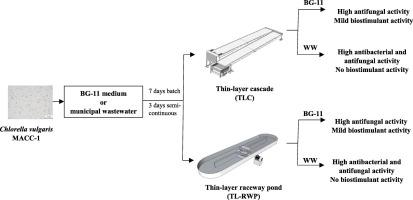Algal Research ( IF 4.6 ) Pub Date : 2020-11-19 , DOI: 10.1016/j.algal.2020.102136 Karolína Ranglová , Gergely Ernö Lakatos , João Artur Câmara Manoel , Tomáš Grivalský , Francisca Suárez Estrella , Francisco Gabriel Acién Fernández , Zoltán Molnár , Vince Ördög , Jiří Masojídek

|
The use of wastewater (WW) for cultivation contributes to the sustainability of microalgae production due to the reduced costs of cultivation. The main objective of this work was to study growth, physiological performance and bioactivity of the microalgae strain Chlorella vulgaris MACC-1 grown in two nutrient sources – inorganic BG-11 medium and centrate from municipal WW. For the comparison, two thin-layer cultivation units – thin-layer cascade and a novel, thin-layer raceway pond – were used. The cultures grew well in both units showing good photosynthetic activity. The germination index of watercress seeds, as well as the auxin-like activity in mung bean and cytokinin-like activity in wheat growth tests were used to evaluate the biostimulant potential. The slight increase on the germination index was determined in C. vulgaris cultures grown in BG-11, but the biomass revealed no biostimulant activity when cultivated in WW. On the other hand, the antibacterial and antifungal activities determined by antagonism bioassay using dual cultures were significantly higher when grown in WW. We expect that the antimicrobial activities may be induced by WW-microbes and the biostimulating effect could probably be suppressed by the presence of some inhibiting substances. The results revealed a clear interplay among ambient irradiance intensity, growth rate, maximum quantum yield of PSII, Fv/Fm and oxygen production/respiration.
中文翻译:

在无机培养基和废水中户外培养的MACC-1小球藻菌株的生长,生物刺激和生物农药活性
由于降低了耕作成本,将废水(WW)用于耕作有助于微藻生产的可持续性。这项工作的主要目的是研究微藻小球藻小球藻的生长,生理性能和生物活性。MACC-1有两种养分来源-无机BG-11培养基和市政二战浓缩液。为了进行比较,使用了两个薄层栽培单元-薄层级联和一个新颖的薄层水槽池。在两个单元中的培养物生长良好,显示出良好的光合作用活性。用豆瓣种子的发芽指数,绿豆中的生长素样活性和小麦生长试验中的细胞分裂素样活性来评估生物刺激潜力。在寻常梭菌中确定了发芽指数的轻微增加BG-11中生长的细菌培养物,但是在WW中培养时,生物量没有显示出生物刺激活性。另一方面,当在WW中生长时,使用双重培养物通过拮抗生物测定法确定的抗菌和抗真菌活性明显更高。我们期望WW微生物可能会诱导抗菌活性,并且某些抑制物质的存在可能会抑制其生物刺激作用。结果表明,环境辐照强度,生长速率,PSII的最大量子产率,F v / F m和氧气产生/呼吸之间存在明显的相互作用。









































 京公网安备 11010802027423号
京公网安备 11010802027423号